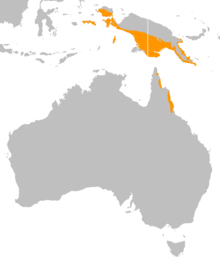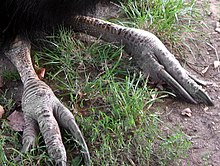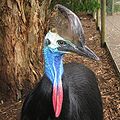Southern cassowary
| Southern cassowary | |
|---|---|

| |
| Individual at the Prague Zoo | |
| Scientific classification | |
| Kingdom: | Animalia |
| Phylum: | Chordata |
| Class: | Aves |
| Infraclass: | Palaeognathae |
| Order: | Casuariiformes |
| Family: | Casuariidae |
| Genus: | Casuarius |
| Species: | C. casuarius
|
| Binomial name | |
| Casuarius casuarius | |

| |
| Native distribution of the southern cassowary | |
| Synonyms | |
|
See text | |
The southern cassowary (Casuarius casuarius), also known as double-wattled cassowary, Australian cassowary or two-wattled cassowary,[2] is a large flightless black bird. It is one of the three living species of cassowary, alongside the dwarf cassowary and the northern cassowary. It is a ratite and therefore related to the emu, ostriches, rheas and kiwis.
Taxonomy[]

Presently, most authorities consider the southern cassowary monotypic, but several subspecies have been described.[3] It has proven very difficult to confirm the validity of these due to individual variations, age-related variations, the relatively few available specimens (and the bright skin of the head and neck – the basis upon which several subspecies have been described – fades in specimens), and that locals are known to have traded live cassowaries for hundreds, if not thousands of years, some of which are likely to have escaped/been deliberately introduced to regions away from their origin.[3]
Cassowaries are closely related to the kiwis, both families diverging from a common ancestor approximately 40 million years ago.[3]
The binomial name Casuarius casuarius is derived from its Malay name kesuari.[4] The southern cassowary was first described by Carl Linnaeus, in his 18th-century work Systema Naturae, as Struthio casuarius,[5] from a specimen from Seram, in 1758.[2] It is now the type species of the genus Casuarius.[2]
The southern cassowary has been described under a large number of scientific names, all of which are now considered taxonomic synonyms for the species.[6]
| Synonyms |
|---|
| Struthio casuarius Linnaeus 1758 |
| Casuarius casuarius altijugus Sclater 1878 |
| Casuarius altijugus Sclater 1878 |
| Casuarius casuarius aruensis Schlegel 1866 |
| Casuarius aruensis Schlegel 1866 |
| Casuarius australis Wall 1854 |
| Casuarius casuarius beccarii Sclater 1875 |
| Casuarius beccarii Sclater 1875 |
| Casuarius bicarunculatus Sclater 1860 |
| Casuarius casuarius bicarunculatus Sclater 1860 |
| Casuarius bistriatus van Oort 1907 |
| Casuarius casuarius bistriatus van Oort 1907 |
| Casuarius casuarius casuarius Linnaeus 1758 |
| Casuarius casuarius chimaera Rothschild 1904 |
| Cassowara eximia Perry 1811 |
| Casuarius casuarius grandis Rothschild 1937 |
| Casuarius galeatus Bonnaterre 1790 |
| Casuarius casuarius hamiltoni Mathews 1915 |
| Casuarius casuarius intensus Rothschild 1898 |
| Casuarius bicarunculatus intermedius Rothschild 1928 |
| Casuarius casuarius intermedius Rothschild 1928 |
| Casuarius casuarius johnsonii Müller 1866 |
| Casuarius johnsonii Müller 1866 |
| Casuarius casuarius lateralis Rothschild 1925 |
| Casuarius casuarius salvadorii Oustalet 1878 |
| Casuarius salvadorii Oustalet 1878 |
| Casuarius casuarius sclaterii Salvadori 1878 |
| Casuarius sclaterii Salvadori 1878 |
| Casuarius casuarius tricarunculatus Beccari 1876 |
| Casuarius bicarunculatus tricarunculatus Beccari 1876 |
| Casuarius tricarunculatus Beccari 1876 |
| Casuarius casuarius violicollis Rothschild 1899 |
| Hippalectryo indicus Gloger 1842 |
| Casuarius hagenbecki Rothschild 1904 |
Description[]

The southern cassowary has stiff, bristly black plumage, a blue face and a long neck, red on the cape and two red wattles measuring around 17.8 cm (7.0 in) in length hanging down around its throat. A horn-like brown casque, measuring 13 to 16.9 cm (5.1 to 6.7 in) high, sits atop the head. The bill can range from 9.8 to 19 cm (3.9 to 7.5 in). The three-toed feet are thick and powerful, equipped with a lethal dagger-like claw up to 12 cm (4.7 in) on the inner toe. The plumage is sexually monomorphic, but the female is dominant and larger with a longer casque, larger bill and brighter-coloured bare parts. The juveniles have brown longitudinal striped plumage. It is perhaps the largest member of the cassowary family and is tied as the third heaviest bird on earth (after the Somali ostrich and the common ostrich), at a maximum size estimated at 85 kg (187 lb) and 190 cm (75 in) tall. Normally, this species ranges from 127 to 170 cm (50–67 in) in length.[2] The height is normally 1.5 to 1.8 m (4.9–5.9 ft); females average 58.5 kg (129 lb), while males average 29 to 34 kg (64–75 lb). The northern cassowary is about the same size on average and is perhaps very mildly less sexually dimorphic than the southern.[2][7] Most adult birds will weigh between 17 and 70 kg (37 and 154 lb).[8] It is technically the largest Asian bird (since the extinction of the Arabian ostrich) and the largest Australian bird (though the emu may be slightly taller).
Range and habitat[]
The southern cassowary is distributed in Indonesia, Papua New Guinea and northeastern Australia.[9] It mainly inhabits tropical rainforests but may make use of nearby savannah forests or mangroves stands.[1] The species prefers elevations below 1,100 m (3,600 ft) in Australia,[2] and 500 m (1,600 ft) on New Guinea.[1]
| Location | Population | Trend |
|---|---|---|
| Southern New Guinea | Unknown | Declining |
| Seram | Unknown | Unknown |
| Aru Islands | Unknown | Unknown |
| Northeastern Australia | 1,500 to 2,500 | Declining |
| Paluma Range | Unknown | Declining |
| McIlwraith Range | 1,000+ | Declining |
| Jardine River National Park | Unknown | Unknown |
| Total | 2,500+ | Declining |
Behavior[]

Southern cassowaries forage on the forest floor for fallen fruit and are capable of safely digesting some fruits toxic to other animals. They also eat fungi, and some insects and small vertebrates. Inspection of the feces reveals that commonly ingested fruits are Davidsonia pruriens, and members of the laurel family (Lauraceae).[10]
The southern cassowary is a solitary bird, which pairs only in breeding season, in late winter or spring. The male builds a nest on the ground,[2] a mattress of herbaceous plant material 5 to 10 centimetres (2–4 in) thick and up to 100 centimetres (39 in) wide. This is thick enough to let moisture drain away from the eggs. The male also incubates the eggs and raises the chicks alone. A clutch of three or four eggs are laid measuring 138 by 95 millimetres (5.4 in × 3.7 in). They have a granulated surface and are initially bright pea-green in colour although they fade with age.[2][11] Southern cassowaries make a thunderous call during mating season and hissing and rumblings otherwise. Chicks will make frequent high-pitched contact whistles and chirps to call the male.[1]
Southern cassowaries have a reputation for being dangerous to people and animals, and are often regarded as aggressive. The birds can jump quite high and kick powerfully with their blade-like claws. However, deadly encounters with southern cassowaries are rare. Only two human deaths have been reported since 1900. A 2003 historical study of 221 southern cassowary attacks showed that 150 had been against humans: 75% of these had been from southern cassowaries that had been fed by people, 71% of the time the bird had chased or charged the victim, 15% of the time they kicked. Of the attacks, 73% involved the birds expecting or snatching food, 5% involved defending their natural food sources, 15% involved defending themselves from attack, and 7% involved defending their chicks or eggs. Only one human death was reported among those 150 attacks.[12]

The first documented human death caused by a southern cassowary was on April 6, 1926. In Australia, 16-year-old Phillip McClean and his brother, age 13, came across a southern cassowary on their property and decided to try and kill it by striking it with clubs. The bird kicked the younger boy, who fell and ran away as his older brother struck the bird. The older McClean then tripped and fell to the ground. While he was on the ground, the cassowary kicked him in the neck, opening a 1.25 cm (0.5 in) wound that may have severed his jugular vein. The boy died of his injuries shortly thereafter.[13]
Another human death due to a southern cassowary was recorded in Florida on April 12, 2019. The bird's owner, a 75-year-old man who had raised the animal, was apparently clawed to death after he fell to the ground.[12]
Being fed by people tempts southern cassowaries into closer associations with human-inhabited areas, increasing the already high risk of vehicle strikes - a major cause of southern cassowary mortality - and increasing the likelihood of encounters with humans.[14] Many "aggressive" birds are simply responding to having been fed by humans in the past. Unfortunately the poor reputation of this species leads to confusion and misinformation among the public, which hampers conservation efforts of this shy bird.
In a 2017 Australian Birdlife article, Karl Brandt suggested Aboriginal encounters with the southern cassowary may have inspired the myth of the bunyip.[15]
Conservation[]
Although subject to ongoing habitat loss, limited range, and overhunting in some areas, the southern cassowary as of 2017 evaluated as Least concern on the IUCN Red List of Threatened Species.[1] The Australian population is listed as Endangered under Federal and Queensland State legislation.[16] Some threats are habitat loss (logging), feral animals eating their eggs, hunting, and roadkill.[1][2] Road building, feral animals and hunting are the worst of these threats. It has an occurrence range of 396,000 km2 (153,000 sq mi), and between 10,000 and 20,000 birds were estimated in a 2002 study, with between 1,500 and 2,500 in Australia.[1] Southern cassowaries have been bred in many zoos around the world, like at White Oak Conservation in Yulee, Florida, United States.[17]
Gallery[]

Upper body
Egg at Museum Wiesbaden

Chick at Artis Zoo, Netherlands

An older juvenile walking across a road in Australia

Adult male with two chicks at Artis Zoo

Mount Hypipamee National Park, Australia
References[]
- ^ a b c d e f g h BirdLife International (2018). "Casuarius casuarius". IUCN Red List of Threatened Species. 2018: e.T22678108A131902050. doi:10.2305/IUCN.UK.2018-2.RLTS.T22678108A131902050.en. Retrieved 19 November 2021.
- ^ a b c d e f g h i Davies, S.J.J.F. (2003). "Cassowaries". In Hutchins, Michael (ed.). Grzimek's Animal Life Encyclopedia. 8 Birds I Tinamous and Ratites to Hoatzins (2nd ed.). Farmington Hills, MI: Gale Group. pp. 75–79. ISBN 0-7876-5784-0.
- ^ a b c Davies, S. J. J. F. (2002). Ratites and Tinamous. Oxford University Press. ISBN 0-19-854996-2.
- ^ Gotch, A.F. (1995) [1979]. "Cassowaries". Latin Names Explained. A Guide to the Scientific Classifications of Reptiles, Birds & Mammals. New York, NY: Facts on File. pp. 178–179. ISBN 0-8160-3377-3.
- ^ Linnaeus, C (1758). Systema naturae per regna tria naturae, secundum classes, ordines, genera, species, cum characteribus, differentiis, synonymis, locis. Tomus I. Editio decima, reformata. Holmiae. (Laurentii Salvii). p. 155. Archived from the original on 19 March 2015.
S. pedibus tridactylís, vertice palearibusque nudis
- ^ Peron, Richard. "Taxonomy of the Genus Casuarius". Archived from the original on 5 March 2016. Retrieved 4 May 2016.
- ^ "Southern Cassowary Species account". Animal Life Resource.
- ^ Burnie, D; Wilson, DE (2005). Animal: The Definitive Visual Guide to the World's Wildlife. DK Adult. ISBN 0789477645.
- ^ Clements, James (2007). The Clements Checklist of the Birds of the World (6th ed.). Ithaca, NY: Cornell University Press. ISBN 978-0-8014-4501-9.
- ^ "Casuarius casuarius (Southern cassowary)".
- ^ Beruldsen, G (2003). Australian Birds: Their Nests and Eggs. Kenmore Hills, Qld: self. p. 156. ISBN 0-646-42798-9.
- ^ a b Kofron, Christopher P. (December 1999). "Attacks to humans and domestic animals by the southern cassowary (Casuarius casuarius johnsonii) in Queensland, Australia". Journal of Zoology. 249 (4): 375–81. doi:10.1111/j.1469-7998.1999.tb01206.x.
- ^ Kofron, Christopher P. (2003). "Case histories of attacks by the southern cassowary in Queensland". Memoirs of the Queensland Museum. 49 (1): 335–8.
- ^ Kofron, Christopher P.; Chapman, Angela (2006). "Causes of mortality to the endangered Southern Cassowary Casuarius casuariusjohnsonii in Queensland, Australia". Pacific Conservation Biology. 12 (3): 175–179. doi:10.1071/PC060175.
- ^ Brandt, Karl (June 2017). "Bunyip Hunters". Australian Birdlife. 6 (2): 10.
- ^ Science, jurisdiction=Queensland; sector=government; corporateName=Department of Environment and (31 August 2005). "Southern cassowary". ehp.qld.gov.au. Retrieved 24 October 2018.
- ^ "Double-Wattled Cassowary". Retrieved 21 June 2013.
External links[]
| Wikimedia Commons has media related to: Casuarius casuarius (category) |
- ARKive - images and movies of the Southern Cassowary (Casuarius casuarius)
- BirdLife Species Factsheet
- Red Data Book
- Southern Cassowary videos on the Internet Bird Collection
- The Cassowary (text and images)
- Significant impact guidelines for the endangered southern cassowary (Casuarius casuarius johnsonii) Wet Tropics population
- IUCN Red List least concern species
- Casuariidae
- Birds of the Maluku Islands
- Birds of the Aru Islands
- Birds of Papua New Guinea
- Birds of Cape York Peninsula
- Vulnerable fauna of Australia
- Nature Conservation Act endangered biota
- Flightless birds
- Birds described in 1758
- Taxa named by Carl Linnaeus






